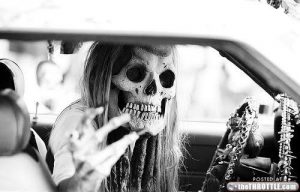 It’s the Halloween season and the City is warning the populace to beware the demon drivers. With the sun setting earlier, pedestrians and cyclists are less visible in the dark – the perfect time to scare up more Vision Zero Enforcement.
It’s the Halloween season and the City is warning the populace to beware the demon drivers. With the sun setting earlier, pedestrians and cyclists are less visible in the dark – the perfect time to scare up more Vision Zero Enforcement.
On October 27th the de Blasio administration announced its “dusk and darkness” safety campaign. This $1.5 million initiative is said to include radio and TV ads, billboards, bus signs and police officers handing out warning leaflets on busy street corners. They will also be handing out more tickets. “Muscular enforcement” is how Mayor de Blasio described the stepped up early evening hour ticketing of drivers who fail to yield to pedestrians, speed, use their cellphones and block bike lanes. Will the City be giving out tickets to those who jaywalk? No, said the Mayor on WCBS88 radio on the day of the program’s roll out. But we “reserve the right to”.
In an eerie coincidence, while the City was rolling out its latest Vision Zero initiative, Patrolmen’s Benevolent Association President, Patrick J. Lynch, in an Op Ed piece in the NY Times, wrote that reducing public safety to a numbers game drives a wedge between the officers and the public, “making our jobs dependent on meeting these mandates”. (For Real Community Policing, Let Officers Do Their Jobs NY Times October 27, 2016). While Lynch is writing of community policing, his argument that a numerically driven enforcement model widens the gulf between the police and the communities they serve is spot on.
Is this increased ticketing of motor vehicle drivers helping us meet the Mayor’s Vision Zero goals? Well… no. In the last year traffic deaths, have gone up. As of Monday, October 24, there have been 192 traffic fatalities up, from 177 at this time last year. WCBS 990 Radio Vision Zero Traffic Related Deaths Rise – October 27, 2016 That’s more than an 8% increase from 2015 to 2016. In the same period, 96 of the traffic fatalities involved pedestrians. In 2016 that number is up to 114. This is an 18% increase.
So, if increased ticketing is not leading to reduced fatalities, how are we going to get to Zero? Rather than just getting those ticket numbers up we need more agents directing traffic and pedestrians at busy intersections. We need more education: for drivers about signaling, sharing the road and scanning for pedestrians when turning; and for cyclists and pedestrians, about being visible, being more attentive to the motor vehicles that may cross their paths than their phones, and anticipating the wide turns and blind spots of our larger commercial vehicles. If we truly want to get to Zero, we must work both sides of the equation. Sure, most of the responsibility rightly falls on the operators of motor vehicles. But if we must share the streets, pedestrians and cyclists have a duty – to themselves – to pay attention.
Leave a Reply